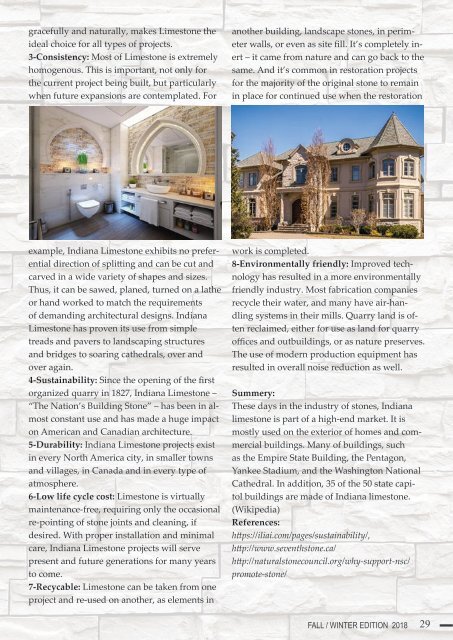Mohandes Magazine Fall-Winter Edition 2018
Create successful ePaper yourself
Turn your PDF publications into a flip-book with our unique Google optimized e-Paper software.
gracefully and naturally, makes Limestone the<br />
ideal choice for all types of projects.<br />
3-Consistency: Most of Limestone is extremely<br />
homogenous. This is important, not only for<br />
the current project being built, but particularly<br />
when future expansions are contemplated. For<br />
another building, landscape stones, in perimeter<br />
walls, or even as site fill. It’s completely inert<br />
– it came from nature and can go back to the<br />
same. And it’s common in restoration projects<br />
for the majority of the original stone to remain<br />
in place for continued use when the restoration<br />
example, Indiana Limestone exhibits no preferential<br />
direction of splitting and can be cut and<br />
carved in a wide variety of shapes and sizes.<br />
Thus, it can be sawed, planed, turned on a lathe<br />
or hand worked to match the requirements<br />
of demanding architectural designs. Indiana<br />
Limestone has proven its use from simple<br />
treads and pavers to landscaping structures<br />
and bridges to soaring cathedrals, over and<br />
over again.<br />
4-Sustainability: Since the opening of the first<br />
organized quarry in 1827, Indiana Limestone –<br />
“The Nation’s Building Stone” – has been in almost<br />
constant use and has made a huge impact<br />
on American and Canadian architecture.<br />
5-Durability: Indiana Limestone projects exist<br />
in every North America city, in smaller towns<br />
and villages, in Canada and in every type of<br />
atmosphere.<br />
6-Low life cycle cost: Limestone is virtually<br />
maintenance-free, requiring only the occasional<br />
re-pointing of stone joints and cleaning, if<br />
desired. With proper installation and minimal<br />
care, Indiana Limestone projects will serve<br />
present and future generations for many years<br />
to come.<br />
7-Recycable: Limestone can be taken from one<br />
project and re-used on another, as elements in<br />
work is completed.<br />
8-Environmentally friendly: Improved technology<br />
has resulted in a more environmentally<br />
friendly industry. Most fabrication companies<br />
recycle their water, and many have air-handling<br />
systems in their mills. Quarry land is often<br />
reclaimed, either for use as land for quarry<br />
offices and outbuildings, or as nature preserves.<br />
The use of modern production equipment has<br />
resulted in overall noise reduction as well.<br />
Summery:<br />
These days in the industry of stones, Indiana<br />
limestone is part of a high-end market. It is<br />
mostly used on the exterior of homes and commercial<br />
buildings. Many of buildings, such<br />
as the Empire State Building, the Pentagon,<br />
Yankee Stadium, and the Washington National<br />
Cathedral. In addition, 35 of the 50 state capitol<br />
buildings are made of Indiana limestone.<br />
(Wikipedia)<br />
References:<br />
https://iliai.com/pages/sustainability/,<br />
http://www.seventhstone.ca/<br />
http://naturalstonecouncil.org/why-support-nsc/<br />
promote-stone/<br />
FALL / WINTER EDITION <strong>2018</strong><br />
29






